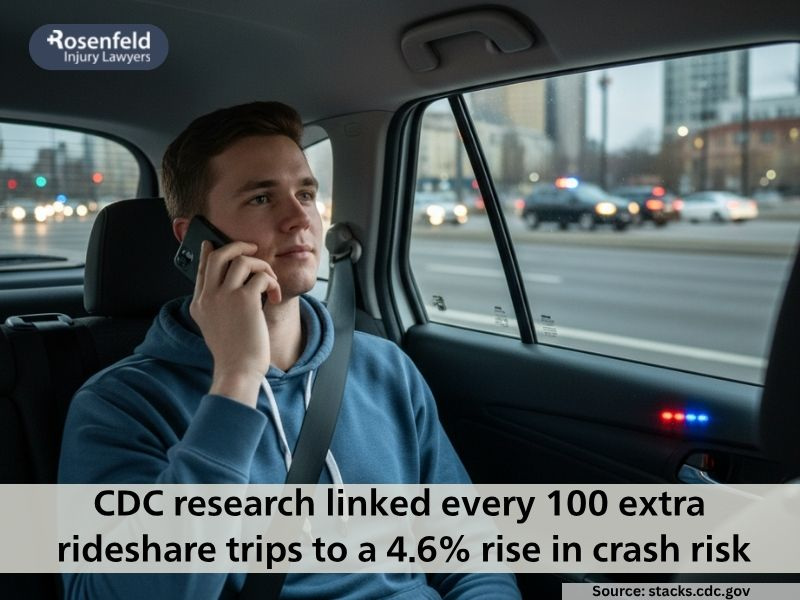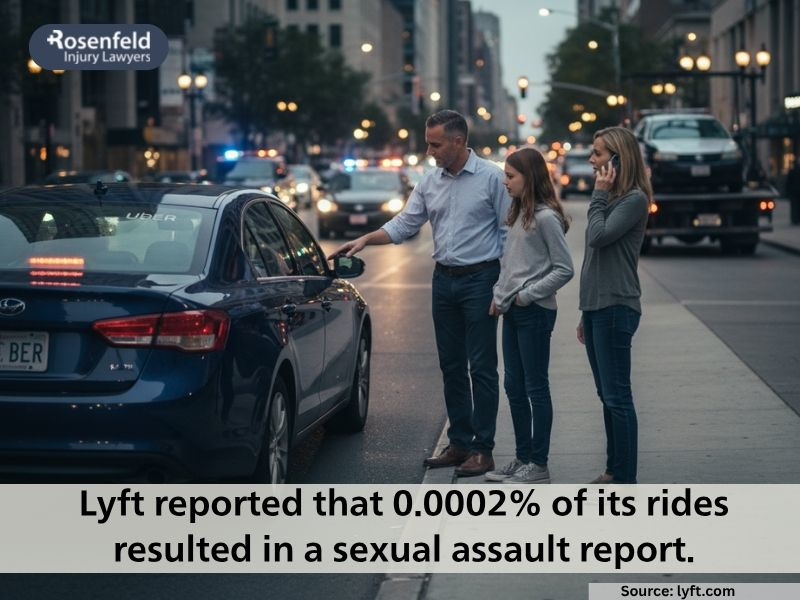- Free Case Evaluation 866-757-6452 Tap Here To Call Us
Rideshare Safety Statistics
Rideshare services like Uber and Lyft have reshaped transportation, offering millions of daily rides across cities and suburbs worldwide. In the U.S. alone, rideshare trips now account for a significant share of urban travel, with many users turning to these platforms for their convenience and accessibility.
But behind the popularity lies growing concern about rideshare apps. As these services continue to expand, so do reports of crashes, assaults, and other safety issues. Understanding rideshare safety statistics is essential, not just for passengers and drivers, but for anyone sharing the road.
This page takes a close look at official safety reports from Uber and Lyft, independent academic research, and national traffic data. We’ll break down fatalities, the most common causes of rideshare accidents, and how serious concerns like distracted driving and impaired driving impact riders.
We’ll also explain what legal options are available for victims of rideshare accidents and related incidents.

Do Rideshare Drivers Have Higher Accident Rates?
While rideshare services are widely seen as convenient alternatives to personal vehicles and taxi companies, data tells a more complicated story about safety. A recent study from the University of Illinois Chicago found that about one in three rideshare drivers reported being involved in a crash while on the job.
According to a recent analysis, the national average for fatalities per 100 million vehicle miles traveled (VMT) has steadily increased–from 1.16 in 2017–2018 to 1.36 in 2021–2022. However, what’s increasingly clear is that companies like Uber and Lyft are also seeing higher accident rates over time:
- Uber’s fatal crash rate rose from 0.58 (2017–2018) to 0.87 (2021–2022).
- Lyft’s rate climbed from 0.75 to 0.94 over the same period.
These trends point to a serious concern as rideshare vehicles become more common on the road. Several factors, like distracted driving, fatigue, and pressure on rideshare drivers to complete more trips, may be contributing to higher accident rates.
What Are the Statistics of Fatal Rideshare Accidents in Recent Years?
In recent years, both Uber and Lyft have published safety reports offering a clearer picture of traffic fatalities connected to their platforms. While rideshare services remain below the national average for fatal injury crashes per 100 million vehicle miles traveled (VMT), the numbers have trended upward.
Uber Fatal Crash Data (2017–2022)
- 2017–2018: 107 fatalities | 0.58 per 100M VMT
- 2019–2020: 101 fatalities | 0.62 per 100M VMT
- 2021–2022: 153 fatalities | 0.87 per 100M VMT
Fatalities connected to Uber rose by 40% between 2020 and 2022. Nearly all occurred in urban areas (97%), and over half involved risky behavior–such as speeding or impaired driving–by third-party drivers, not those using the Uber app. Third-party alcohol-impaired drivers caused one-third.
Lyft Fatal Crash Data (2017–2022)
- 2017–2019: 105 fatalities | 0.76 per 100M VMT
- 2020: 25 fatalities | 0.68 per 100M VMT
- 2021: 36 fatalities | 0.86 per 100M VMT
- 2022: 50 fatalities | 1.02 per 100M VMT
Lyft’s fatal crash rate increased from 0.68 in 2020 to 1.02 in 2022, despite fewer completed trips. The company reported a 14% rise in fatal crash rates and a 31% increase in trip volume over that period.
While rideshare companies emphasize that most fatal crashes involve outside parties, these statistics highlight a troubling pattern. Deadly crashes are rising, and in most cases, involve risky driving behavior–especially alcohol use and speeding, whether by rideshare drivers or others on the road.

What Risks Do Rideshare Drivers Face on the Job?
Driving for a rideshare company means more than just getting passengers from point A to B–it also means facing serious risks that can include violence, theft, and even fatal assaults.
Uber’s most recent safety report shows a sharp increase in physical assault fatalities involving drivers. Between 2021 and 2022, there were 36 Uber-related fatal physical assaults, nearly double the total from 2019 to 2020. These incidents occurred roughly once in every 53 million trips. In this period:
- 61% of victims were Uber drivers
- 32% of driver deaths involved motor vehicle theft, such as carjackings
- In almost half the cases, the attacker was neither the driver nor the rider
These attacks often happened in urban areas, late at night, or while drivers were alone in unfamiliar locations–circumstances that continue to pose high risks for rideshare workers.
Lyft reported 33 fatal assaults between 2017 and 2022, with the highest rate in 2021: one fatality per 62 million trips. The company noted similar threats, including a spike in carjackings and safety issues tied to pandemic-era disputes, such as mask enforcement.
Compared to other jobs, rideshare drivers still make up a small share of workplace homicides–but the gap is closing. From 2017 to 2022, work-related homicides in the U.S. rose from 911 to 1,005, while Uber’s driver-related fatalities increased from 19 to 36 in the same time span. Lyft reported fewer cases overall, with 16 incidents in 2021–2022, an increase from 11 in 2019–2020.
How Common Is Sexual Assault When Using Rideshare Services?
A 2025 investigation by The New York Times uncovered that between 2017 and 2022, Uber received reports of sexual assault or misconduct in the U.S. at an average rate of one every eight minutes. The report, based on sealed court documents, revealed 400,181 incidents over those six years–far exceeding the numbers Uber had publicly reported in its official safety disclosures.
Uber reported 2,717 sexual assault incidents across five categories in its most recent two-year period. These included:
- 1,401 cases of non-consensual touching of a sexual body part
- 355 reports of non-consensual sexual penetration
- 285 attempted penetrations
- 338 non-consensual sexual kisses
- 338 non-sexual body part kisses
These incidents amount to roughly one report per 70 million trips. Although the overall number of reports declined by 22% compared to the previous reporting period, Uber noted that non-consensual sexual penetration reports actually rose by 6%. Victims may be drivers or passengers, and in many cases, the accused is a rider.
Lyft received 1,038 sexual assault reports in 2022. The most common category was non-consensual touching of a sexual body part (615 cases), followed by non-consensual sexual penetration (135 cases) and attempted penetration (74 cases).
These incidents occurred at a rate of about one per 520,000 rides, or 0.00019% of all trips. While these percentages are low, the raw numbers are disturbing. Survivors of rideshare sexual assault deserve to be heard and protected. If you or someone you love has experienced assault during a rideshare trip, contact us for a free consultation to learn your legal options.
What Safety Measures Are Rideshare Companies Taking?
Uber has invested heavily in safety initiatives across its platform, aiming to better protect both drivers and passengers. From background checks to real-time alerts, the company’s safety efforts span technology, education, enforcement, and partnerships, promoting a zero-tolerance policy to assault.
Screening and Account Controls
- 750,000+ driver applicants were denied access in 2021–2022 due to background checks.
- Uber removed over 185,000 drivers after continuous re-screening.
- 15,000+ rider accounts were banned for fake names or fraudulent behavior.
- Riders using gift cards or anonymous payments must verify their identity.
- A verified rider badge was introduced in over a dozen U.S. cities to give drivers peace of mind.
In-App Safety Features
- RideCheck detects unusual trip activity, such as long stops or possible crashes.
- Emergency Button allows riders and drivers to quickly contact 911.
- Audio Recording is now available nationwide, and Record My Ride is live in 35 states.
- PIN verification, anonymized communication, and safety toolkits further support safer rides.
- Seat-belt audio reminders now include voice prompts to encourage use.
Road Safety Technology
- Uber’s navigation reduces left turns–linked to over 22% of crashes per NHTSA data.
- New alerts warn drivers when approaching risky intersections without complete traffic control.
- Driving Insights dashboards help drivers improve habits with feedback.
Safety Incident Response
- A dedicated 24/7 Safety Support Team handles reports, with over 200 hours of specialized training per agent.
- Uber can suspend accounts immediately and connect survivors to the RAINN-backed support fund.
Broader Commitments
- Uber partnered with experts on its Safety Advisory Board and donated $10 million to gender-based violence prevention efforts.
- The company has worked with Mothers Against Drunk Driving and state agencies to reduce DUI fatalities–saving an estimated 600 lives in one year.
These safety measures reflect a growing recognition that riders and drivers face real risks–and that accountability starts with prevention, transparency, and action.

What Legal Options Do Uber and Lyft Accident and Assault Victims Have?
Victims of rideshare accidents or assaults may have several legal options available depending on the circumstances. These can include both personal injury and civil claims against the individuals involved–and in some cases, against Uber or Lyft themselves.
If you were injured in a rideshare accident caused by a negligent driver, you may be entitled to file a personal injury lawsuit. This applies whether the driver was speeding, distracted, impaired, or otherwise reckless during an active trip or while en route to pick up a passenger.
Victims of rideshare sexual assault or physical violence may file civil lawsuits against the offender directly. In some cases, Uber or Lyft may also be named as defendants if the company’s negligence—such as failing to properly vet, monitor, or suspend a driver—contributed to the harm. This can include claims for negligent hiring, negligent supervision, or failure to act on prior complaints.
In fatal rideshare crashes or assaults, surviving family members may pursue wrongful death claims. These can be brought against the at-fault driver, a third party, or the rideshare company if its actions (or inaction) played a role.
Depending on the situation, multiple insurance policies may be triggered:
- The rideshare driver’s personal auto policy
- Uber or Lyft’s commercial policy (which applies during active trips)
- Uninsured or underinsured motorist coverage (if another driver caused the crash and lacked coverage)
Uber and Lyft may be held liable under vicarious liability if the driver was acting within the scope of their role during the incident. They may also face claims for negligent hiring or retention if the driver had a history of dangerous behavior that the company overlooked.
However, both companies often argue that their drivers are independent contractors, not employees, to limit their legal exposure. That classification is frequently challenged in court–especially when victims claim that Uber or Lyft should have done more to prevent the incident.
Liability also depends on the driver’s status at the time:
- If the driver was completing a trip or en route to a pickup, Uber or Lyft’s insurance may apply.
- If the driver was waiting for a ride request, coverage may be more limited.
- If the driver was offline, the company is generally not liable.
Understanding your legal rights and the insurance layers involved can be complicated. That’s why speaking with a qualified attorney can help determine what claims you may have–and how to pursue compensation. We offer a free consultation to review your case and explain your legal options.
What Damages Can Victims Recover After a Rideshare Accident or Assault?
Victims of rideshare accidents or assaults may be entitled to recover several types of damages. These fall into three main categories:
- Economic damages: These cover out-of-pocket losses such as medical bills, physical therapy, lost income, funeral costs, and counseling expenses.
- Non-economic damages: These address the personal impact of the incident, including physical pain, emotional suffering, mental health effects, and loss of companionship in wrongful death cases.
- Punitive damages: In cases involving gross negligence, repeated safety failures, or intentional acts like sexual assault, punitive damages may be awarded to punish the offender and deter similar conduct.
The goal of these damages is not only to help victims regain financial and emotional stability, but also to hold rideshare companies accountable when their policies–or lack of enforcement–put riders and drivers at risk.
How Long Do Victims Have to Take Legal Action?
The time limit to file a legal claim after a rideshare accident or assault depends on the type of case and the state where it occurred. In most states, the statute of limitations is two years for personal injury or wrongful death claims. However, cases involving sexual assault may have more extended filing periods–especially if the victim was a minor or if state laws have been updated to allow more time.
Insurance claims often require much faster action. Victims may need to notify the insurance provider or rideshare company within 30 to 180 days, depending on the policy.
It’s critical to act quickly. Rideshare companies store necessary digital evidence–such as GPS logs, trip data, and in-app communications–that may be lost or difficult to access over time. Consulting with an attorney early can help preserve that evidence and protect your right to compensation. We offer a free consultation to help you get started.

How Injury Lawyer Team Can Help
At Injury Lawyer Team, we stand with victims of rideshare accidents and assaults. We know how overwhelming these experiences can be–and you don’t have to face them alone. Our firm takes each case seriously because we believe every rider and driver deserves safety, accountability, and respect.
We investigate driver history, analyze app data, GPS logs, and communication records, and look closely at whether Uber or Lyft failed to act on red flags. If a company’s negligence contributed to your harm, we’re committed to helping you hold them responsible.
All consultations are completely confidential, and we represent clients on a contingency basis–meaning you pay nothing unless we recover for you. If you’ve been injured or assaulted during a rideshare trip, we’re here to listen, support your next steps, and fight for the justice you deserve.
Book a Free Consultation
If you’ve been injured or assaulted while using a rideshare service like Uber or Lyft, our team is ready to support you. At Injury Lawyer Team, we offer a free consultation so you can speak with a sexual assault lawyer, ask questions, and understand your rights, without any obligation.
We’ll walk you through what legal options may be available and whether you have a case. If we move forward, you won’t pay anything unless we win for you.
You deserve answers, and you don’t have to face this alone. Contact us today to talk privately with an experienced attorney.








